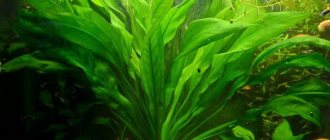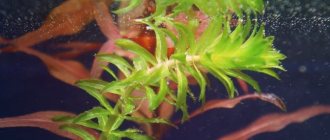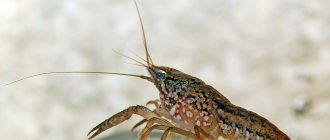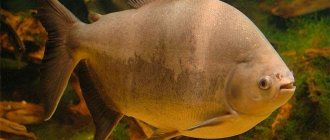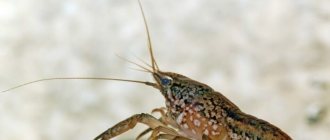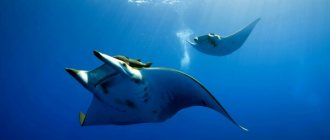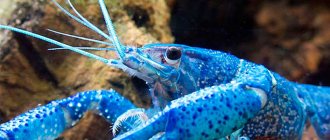4.9
(7)
Today there are incredibly many varieties of underwater flora. Moreover, naturalists discover new species almost every day. Some families are even represented in a wide variety, and therefore are very popular among both beginners and experienced aquarists. Pogostemon can also be classified as such.
Appearance of octopus
A species called octopus (Pogostemon octopus) is common in aquatic habitats in Southeast Asia, India, Africa, Australia and Oceania. The plant appeared in European pet stores about 10 years ago. Since then, octopus has become a popular aquarium species, used to decorate the background of the underwater landscape.
In appearance, octopus shoots resemble fluffy branches of coniferous plants: erect stems are densely covered with long (up to 9 cm) and narrow (up to 0.6 cm) leaves collected in whorls. Underwater currents cause the leaves to move, causing them to move and become like the tentacles of an octopus. Because of this similarity, the plant received the name octopus, which is translated from Latin as “octopus.”
An aquarium plant is capable of changing the color, size and density of green leaves with any deviations in light, temperature and chemical composition of the aquatic environment. Thus, intense light will lead to the appearance of a red-brown tint on the shoots, and a lack of nitrogen will slow down the growth of pogostemon.
Closest relatives
The most common relatives of Octopus are:
- Australian. The shoots of young specimens have a pink tint, but as they mature they become grassy green.
- Kimberly. The stems and leaves are pinkish-brown.
- Stellatus (stellate). Capricious and difficult to care for. May die with slight deviations in hardness or acidity from the norm.
- Helfery. Forms numerous basal rosettes with beautiful corrugated leaves.
- Sri Lanka. The lower part of the leaves is purple-pink.
- Erectus. The most unpretentious of all pogostemons.
- Yatabeanus. Retains decorative properties under different lighting and water conditions.
When placing several varieties of pogostemon in one tank, you should take into account the size of the plants at maturity and place them so that the tall species do not cover the short ones. For example, it is better to plant octopus near the back wall of the aquarium, and helferi - in the middle ground.
The value of fertilizing
Feeding is very important. Most often, it is necessary to apply fertilizers to the soil at the root, since through it the pogostemon receives most of the nutrients.
With sufficient nutrition, the bush forms many side shoots and delights with the brightness of its color.
In addition, in a good substrate, the little star develops an impressive root system, but in an empty one, only a couple of weak roots.
A signal of a lack of fertilizer can be a pale color. A change in color to yellowish-brown is not an alarming symptom; many adult specimens acquire this shade. But if you want to keep the leaves of the bush green, it is enough to increase the amount of potassium in the fertilizing composition.
Types of aquarium pogostemon
The genus Pogostemon, according to different taxonomies, includes from 90 to 96 species, but only 6 of them can be seen in aquariums.
Erectus
Pogostemon erectus.
Long shoots of erectus look impressive in the background of a home pond. Whorls consist of 8 leaves up to 4 cm long and up to 1 cm wide.
In 1-3 months, several young branches can turn into dense thickets. Adult specimens reach 40 cm in length and 15 cm in width.
To prevent plants from growing uncontrollably and taking over most of the aquarium, they need to be periodically pruned and thinned.
Octopus
Under favorable conditions, octopus stems can grow up to 60 cm in height and 25 cm in width. Thin, densely leafy shoots planted along the back wall of the aquarium do not cast a dense shadow and do not interfere with the development of the rest of the underwater flora.
Helfery
The plant has compact sizes and beautiful leaf shapes. The leaves are collected in dense whorls, similar to green fountains. The height of the helperi does not exceed 10 cm, and the diameter of the bush is 5-10 cm. The main color of the leaf blades is juicy green, but there are also rarer varieties with a two-color color. The pearl of any collection can be Pogostemon Helferi Red, the young leaves of which have a red tint.
Kimberly
A distinctive feature of Pogostemon kimberley is the presence of serrations along the edges of the leaf blades. Lush bushes 25-40 cm high will look good in the center of a composition of different plants or near the side walls of the aquarium.
Pogostemon kimberley.
Stelatus
Eusteralis stellata is the second name for Pogostemon stellate. It grows relatively quickly and can reach the surface of the water in a few months, so it will look better in tanks with a volume of 200 liters or more. The dense whorls of the plant consist of 8-11 narrow (up to 5 mm) and long (up to 6 cm) leaves.
Yatabeanus
The plant's homeland is considered to be rice fields and irrigation canals in Korea, China and other East Asian countries. Yatabeanus can bloom at home. During flowering, a spike-shaped inflorescence appears above the surface of the water, consisting of many small lilac buds.
general information
Staurogyne Repens is a small, resilient tropical plant that has bright green foliage and a host of unique properties. The new species was first discovered by botanist Klaus Christenos while participating in an expedition through the Amazon jungle. Having seen many green accumulations on the surface of the water and stones, the scientist suggested that it was Hygrophila (the closest relative of Staurogin). The shrub received its current name much later.
Creeping staurogyne grows up to ten centimeters in height, while its width is no more than 5-10 cm. The size of the leaves is 4.5 cm, their shape is lanceolate-oval, and their color is green. During the flowering period, the tropical shrub is covered with white flowers, which resembles its close relative - Hygrophila. However, its growth and development is much slower.
Conditions for keeping pogostemon in the aquarium
All representatives of the genus Pogostemon differ in botanical description, but require the same conditions of detention. They develop better in reservoirs with established biological equilibrium. It is not recommended to plant young bushes in a freshly started aquarium - the plants either will not survive or will get sick and wither.
Keeping pogostemon in an aquarium.
Water
To make the green thickets of Pogostemon look attractive, you need to control the chemical composition of the aquarium water and its temperature.
The main indicators of the aquatic environment in which the plant can grow and reproduce vigorously:
| Temperature | +22…+28°С |
| Acidity (pH) | 6,0-7,5 |
| Hardness (dH) | 6-12°F |
A prerequisite for growing an octopus or other related species is a weekly water change of at least 25-30% of the total volume of the aquarium.
Priming
Soil for the aquarium plant Pogostemona.
The powerful, developed root system of pogostemon requires reliable support, so the soil layer should be at least 5-6 cm.
It is better to use a silted substrate from which the plant will receive the necessary nutrients. Coarse river sand, fine gravel or quartz are also suitable as a substrate.
When placed in an infertile substrate, the plant must be regularly fed with liquid fertilizers.
Active growth requires an uninterrupted supply of CO₂ at a rate of 5-10 to 10-20 mg per 1 liter.
Lighting
With a lack of light - low light or short daylight hours - the leaves of the plant turn pale, stretch out, become thinner and look unattractive. To maintain the decorativeness of the pogostemon, fluorescent lamps of the LB brand must work daily for at least 10-12 hours. The optimal power of lamps is 0.5-1 W/l.
Filtration and aeration
The underwater “octopus” is demanding of water purity. In a cloudy aquarium, numerous leaves quickly become covered with a dirty coating. This spoils the appearance of the plant, slows down its development and metabolic processes in cells.
A powerful filter will help avoid such problems. Its use is advisable for 2 reasons: the device will purify the water and create underwater currents that will set the green “tentacles” in motion.
Why doesn't it grow, possible diseases
The whimsical Pogostemon Octopus is susceptible to any changes around it. Incorrect content will immediately affect its appearance:
- yellowed leaves indicate a loss of calcium - place a clean shell in the aquarium;
- pallor and thinning of the leaves indicate a lack of lighting - increase the light power or its duration;
- slowing down or stopping growth means that the plant does not have enough nitrogen - the water temperature should be slightly lowered and nitrogen-containing fertilizers should be added.
A healthy plant with proper maintenance lives on average 2-4 years.
Pogomtemon octopus is an interesting, attractive plant. It will decorate any aquarium thanks to its unusual curly leaves and bright green color. For all its charms, it requires careful care and constant monitoring of its habitat. With careful attention, pogostemon will give the beauty and diversity of the landscape of the underwater world.
Reproduction methods
Pogostemon aquarium plant.
All varieties of pogostemon are propagated vegetatively - the simplest of all existing ones. For rooting, side shoots or apical cuttings cut from tall specimens are used.
Planting in the ground is done as follows:
- Using a knife, cut off a side shoot or top at least 10 cm long.
- Make a hole in the ground and place a seedling there.
- Sprinkle the depression with the substrate, lightly pressing it with your hands.
After about a month, the seedling adapts and takes root. If you plan to plant several cuttings of Octopus, Kimberly or Helferi in an aquarium, then make a separate hole for each specimen.
The described method is suitable for rejuvenating old specimens that have shed their lower leaves and lost their decorative properties. Cutting off the upper parts of the pogostemon also helps to stimulate the growth of side shoots.
Plant care
Landing
Pogostemon octopus bushes are planted in nutrient soil, at a relative distance from each other. One shoot is placed in each hole. If you plant plants too close to each other, the lower leaves of the bushes will lack light.
CAUTION: Octopus has a fragile stem that can easily break during planting. Therefore, the plant requires careful and attentive handling.
Adaptation
Pogostemon adaptation lasts up to 30 days. During this time, the aquarium plant may lose all its leaves and stop growing. Due to its capricious nature and long adaptation period, Octopus dies in new aquariums with changing parameters of the aquatic environment and is only suitable for well-developed, established bodies of water.
Fertilizers
Pogostemon needs additional nutrition. It should be regularly fed with complex micro- and macro-fertilizers. If there is an iron deficiency, the leaves of the plant will turn yellowish. A couple of days after adding fertilizer to the water, they turn bright green again.
Trimming
In order for the thickets of pogostemon to become dense and lush, you need to occasionally cut off the tops of the plant, thereby stimulating the appearance and development of side shoots. If there are too many side shoots, they should be thinned out, being careful not to damage the fragile stem of the octopus. The cut parts can be used as planting material for growing new bushes.
Return to content
Compatibility with fish and other aquarium inhabitants
Representatives of the genus Pogostemon differ from other hydrophytes in their soft and juicy greenery, which often becomes a source of food for snails and herbivorous fish. To ensure that the plant does not lose its attractiveness and delights with fluffy greenery, it is recommended to plant it in aquariums with predatory fish species.
The proximity to shrimp will also be useful: these crustacean animals will become a kind of cleaners for the pogostemon bushes, removing organic debris and algae from the thin leaves.
Bookmarks 0


